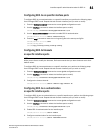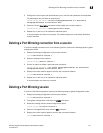
Dell Converged Enhanced Ethernet Administrator’s Guide 115
53-1002116-01
Chapter
12
Configuring sFlow using the CEE CLI
In this chapter
•sFlow protocol overview . . . . . . . . . . . . . . . . . . . . . . . . . . . . . . . . . . . . . . . . 115
•Configuring the sFlow protocol globally . . . . . . . . . . . . . . . . . . . . . . . . . . . . 116
•Interface-specific administrative tasks for sFlow . . . . . . . . . . . . . . . . . . . . 116
sFlow protocol overview
The sFlow protocol is an industry standard technology for monitoring high-speed switched networks
that can be implemented in a broad range of networking devices from Layer 2 switches to high-end
core routers. The sFlow standard consists of an sFlow agent that resides on the device and sFlow
collector that resides on a central server.
An sFlow agent collects statistics from the switch and forwards the data to the sFlow collector at an
IP address somewhere on the network. The sFlow collector stores the sFlow datagrams from all
agents on the network for processing at a later time.
The sFlow datagram provides information about the sFlow version, its originating agent’s IP
address, a sequence number, how many samples it contains and usually up to 10 flow samples or
counter samples.
The sFlow agent uses two forms of operation:
• Time-based sampling of interface counters
• Statistical sampling of switched packets
Interface flow samples
A flow sample is based on random packets being forwarded to the sFlow collector at defined
numeric intervals for a single port interface. For example, every 4,096th packet is forwarded to the
sFlow collector for analysis and storage.
NOTE
This type of random sampling provides estimated flow rates, but not perfect accuracy.
Packet counter samples
A polling interval defines how often the sFlow octet and packet counter for a specific interface are
sent to the collector, but the sFlow agent is free to schedule the start of the polling in order to
maximize internal efficiency. If the regular schedule is chosen, each polling interval start time is
chosen randomly to eliminate bottlenecks in network performance, but the polling interval remains
as configured.


















